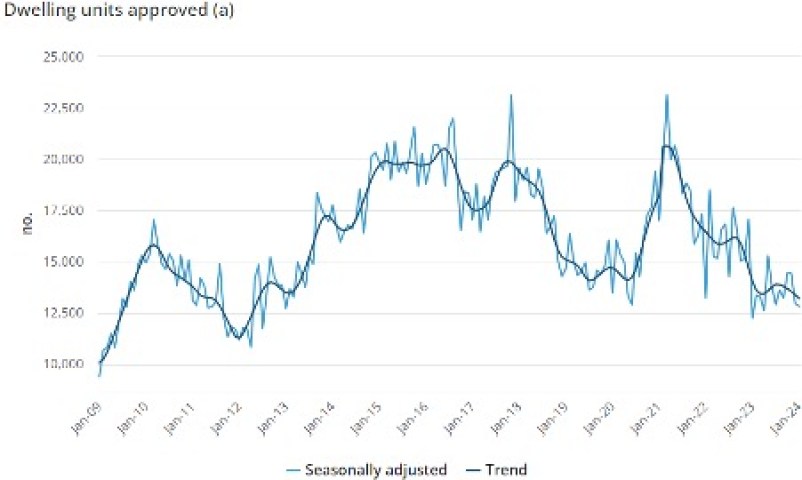Another day (or week or month or whatever), another series of disheartening and depressing housing stories and statistics, all pointing to there being absolutely no end in sight to the crisis and no solution contemplated by any government.
Oh, there are Band-Aids of one sort or another, some of them helpful for some people, but no government can even pretend their policy bibs and bobs will make a significant difference.
And then there’s the federal opposition, barely a shadow of the party of Menzies, that can’t even manage a Band-Aid, content to skip the Bex and just keep lying down.
In short order on the statistical front, we have the combination of the national vacancy rate falling to a record low of 0.7 per cent while the number of dwelling units approved for construction fell again, back to where we were 14 years ago.
At the human scale, Google “housing crisis” and any amount of misery is yours for the reading.
Try the single father of two children, one with cerebral palsy, who has been on the social housing waiting list for four years in regional Victoria, sometimes living in a rundown bus.
Or talk to anyone who is trying to find a rental property. In Perth and Adelaide, the vacancy rate is down to 0.3 per cent. In practical terms for most people, that means no vacancies at all.
Scratching the surface
With housing not keeping up with population growth, the bad news will keep coming.
All our governments basically leaving the provision of shelter to “the market” for three decades has resulted in the federal government spending $6 billion this year on rental assistance, subsidising what people in crisis pay “the market”, a subsidy that still leaves many of the recipients in rental stress.
That $6 billion a year – and growing – compares with Labor’s signature once-off $10 billion Housing Australia Future Fund that is supposed to subsidise 30,000 community housing dwellings.
That will help some people but it won’t scratch the sides of the overall shortage, won’t dent the waiting lists of people who can’t afford inflated and still-inflating housing prices.
Ditto the Help to Buy scheme of the federal government providing up to 40 per cent of the equity for a new home and 30 per cent for an existing home, becoming co-owner of the property.
The Grattan Institute gives Help to Buy a pass mark as, like the HAFF, it will help some people. But the scheme is limited, once again barely scratching the surface and still requiring “the market” to provide the dwellings.
Even with those limitations, the legislation before Parliament is being opposed by the Coalition for its miserable ideological reason of opposing everything and by the Greens as they try to repeat their HAFF success of bargaining for more.
Various state governments (after years of near-criminal public housing neglect) are making plenty of announcements and doing bits and pieces, but those announcements are mostly being used to the cloud reality of not making much difference while the governments blindly hope private developers will solve the crisis for them.
Let’s be brave
None is prepared to grasp the truth nettle explained in Cameron Murray’s book, The Great Housing Hijack, reviewed here last week. Only much larger-scale direct government building of housing has a hope of making a difference to our out-of-control cost spiral and insufficient building.
Speaking to Dr Murray on Friday, he suggested it needs one government to have a crack at something like his suggested HouseMate proposal to demonstrate it working so that it might then be copied.
There is an excellent opportunity for the New South Wales government right now to do just that, to walk the talk with a prime site it already owns and is set for 2000 new dwellings.
With the land being “free”, it could sell those 2000 dwellings for the price of construction to first-home buyers with at least some of the conditions Dr Murray suggests for HouseMate – say, minimum ownership of five years before being allowed to on-sell properties and then only to other people who qualify for HouseMate on the same conditions.
Most of the 2000 dwellings could be further targeted with means testing as “affordable housing”, along with a mixture of community/public housing, providing shelter for the people needed to staff the schools, buses and hospital when teachers, bus drivers, nurses and orderlies are priced out of the area.
Anyone who had been paying attention earlier would by now guess the site – the soon-to-be-relocated Frenchs Forest school and adjoining area which will become a new city centre at the gateway to the northern beaches, 18kms from the Sydney CBD.
But with the Minns government’s housing credibility on the line, Planning Minister Paul Scully has not budged from keeping the previous government’s failed housing policy for the site – at most, a cursory 15 per cent of subsidised community rental housing, nothing about affordable housing.
And the 15 per cent community housing is not what necessarily happens when the developers’ dollars hit the concrete anyway. Developers selling expensive units don’t want community housing in their tower “lowering the tone”.
For example, Meriton last year to offered to include affordable housing in an 800-dwelling development in Sydney’s Zetland – but last month dumped that plan, preferring to pay the City of Sydney a 3 per cent affordable housing levy instead, reportedly about $29 million, so the council can theoretically house poorer folk somewhere else.
Greens councillor Sylvie Ellsmore was on the losing side of the council vote to accept the Meriton deal. She told The Sydney Morning Herald it was a perfect illustration of what was wrong with the state’s planning system, the financial payment being a less-effective way of providing affordable homes because the council had to find another site to build or buy the housing.
“In reality this means affordable housing is built by a community housing provider often years later and at a higher price, which means you get fewer affordable apartments built in the end,” she said.
It’s business as usual for governments and developers, continuing the great housing hijack, continuing to do things pretty much the same old way and, unsurprisingly, getting the same old results.
Wanted: A government game to have a crack at doing something different.











